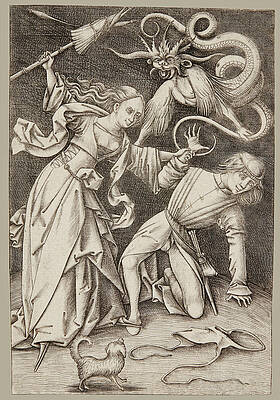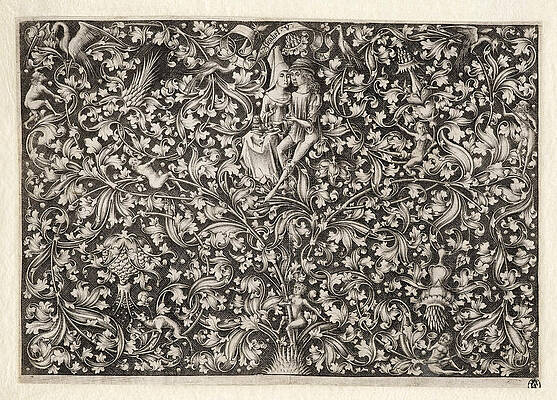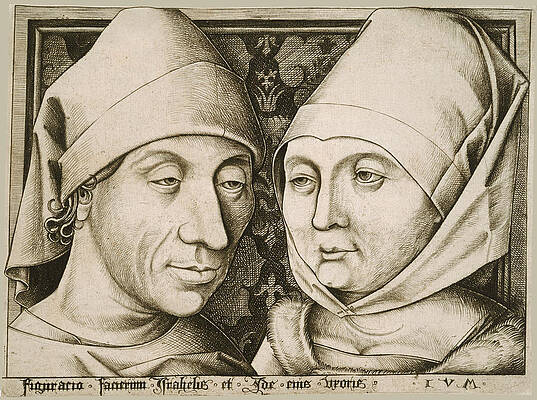Israhel van Meckenem the Younger
Garden of Love
Self-Portrait with His Wife Ida
Israhel van Meckenem (c.1445 – 10 November 1503), also known as Israhel van Meckenem the Younger, was a German printmaker and goldsmith, perhaps of a Dutch family origin.
He was the most prolific engraver of the fifteenth century and an important figure in the early history of old master prints. He was active from 1465 until his death.
Life
A Couple Seated on a Bed, after 1495
His birth date is merely an estimate. Recent guesses range from the early 1430s to 1450. His father arrived in Bocholt, Germany, near the border of the Netherlands, in 1457, and though his place of birth is uncertain, Joachim von Sandrart referred to him as Israel von Mecheln, and Karel van Mander referred to him as Israel van Mentz.[1][2] He was the son of Israhel van Meckenem the Elder, also a goldsmith, who settled in Bocholt. Attempts have been made to identify the father as the Master of the Berlin Passion, an early engraver, but this remains uncertain. Some writers also assign to the father works traditionally given to the son. The very unusual name "Israhel" suggests the family may have had Jewish origins, but Israhel the Younger was buried in a church, and it might not have been possible for Jews to work as goldsmiths. The "van" suggests a Dutch origin for the family; various places in Germany and the Netherlands have been suggested as "Meckenem", as no place generally called exactly that existed at the time. The Master of the Berlin Passion probably worked mainly in the Netherlands, so his identification with Israhel Senior would have implications for the issue of the family origin.
Israhel van Meckenem probably trained initially as a goldsmith and engraver with his father, before travelling to work with Master E. S., the leading Northern European engraver of the day. His earliest dated print comes from 1465, and indicates that he created it in Cleves, modern Kleve, on the Dutch border and then Dutch-speaking, where the family had moved. In 1470 he is documented as working in Bamberg in Bavaria; he returned to Bocholt by about 1480, where he remained for the rest of his life.
He continued to work at goldsmithing. Some surviving pieces are widely accepted as his and many commissions from the Bocholt council are documented between 1480 and 1498. He was evidently a prosperous and established figure in the town. One of his prints is a double portrait of himself and his wife, Ida, whom he married in the late 1480s;[3] another print is believed by some to show his father. He is documented in various lawsuits against neighbours, and Ida was fined for "unseemly speech" as well as for "mocking and scolding public officials".
Work
Pair of Lovers playing Instruments by a fountain, signed "Israhel". Circular engravings such as this may have also been intended as patterns for metal-workers
He probably trained with Master E. S. in South Germany, and may well have been with him at his death c. 1467, since he acquired and reworked forty-one of the master's plates. Another two hundred of van Meckenem's "own" prints also were copies of ones by Master E. S. In total, he produced over six hundred plates, most of which were copies of other prints; they represent about 20% of print production by all Northern European artists in the period of his working life. His career lasted long enough for him to copy Dürer prints.
Apart from the above, he copied prints by the Housebook Master,[4] including some now otherwise lost, Martin Schongauer, and many other German engravers. His famous and very fine late series on the Life of the Virgin appears to have been based on drawings by Hans Holbein the Elder or his workshop, and he may have entered into a regular commercial relationship with Holbein.[5]
His early works were fairly crude, but in the 1480s he developed an effective personal style and made increasingly large and finished works. His own compositions are often very lively, and take a great interest in the secular life of his day. One famous print, supposed to illustrate the story of St John the Baptist and Salome, pushes the specific incidents of the story far in the background to allow space for a scene of court dancers, dressed in the height of contemporary fashion, which takes up most of the plate.[6]
He was sophisticated in self-presentation, signing later prints with his name and town, and producing the first self-portrait print of himself and his wife, which was also the first portrait print of an identifiable person. Some plates seem to have been reworked more than once by his workshop, or produced in more than one version, and many impressions have survived, so his ability to distribute and sell his prints was evidently equally well developed. He was apparently the first to issue engraved (as opposed to woodcut) indulgences, apparently "bootlegged version[s] ... never subject to papal review"; one print promises 20,000 years reduction of time in Purgatory per set of prayers, increased in a second state to 45,000 years.[7]
In the Heures de Charles d'Angoulême, an important manuscript showing the links between printmaking and illumination in the late 15th century, Robinet Testard incorporated sixteen of van Meckenem's prints, gluing them directly on to the vellum then overpainting.[8]
Notes
Israel von Mecheln in Sandrart's Teutsche Akademie
Israel van Mentz in van Mander's Schilder-boeck
Israhel van Meckenem, Self-portrait and Wife, The British Museum
Israhel van Meckenem, Joust of Two Wild Men, Artfinder
Parshall, 57
Israhel van Meckenem, The Dance at the Court of Herod, Artfinder
Parshall, 56-58
Matthews, Anne (1986). "The use of prints in the Hours of Charles d'Angoulême". Print Quarterly. 3 (1): 4–18. JSTOR 41823707.
References
Hutchison, Jane Campbell (1993). Kristin L. Spangenberg (ed), ed. Six centuries of master prints : treasures from the Herbert Greer French collection. Cincinnati: Cincinnati Art Museum. ISBN 978-0-931537-15-8.
Mayor, Alpheus Hyatt (1971). Prints & people; a social history of printed pictures. Metropolitan Museum of Art/Princeton. ISBN 978-0-691-00326-9.
(Parshall): David Landau & Peter Parshall, The Renaissance Print, Yale, 1996, ISBN 0-300-06883-2
Shestack, Alan (1967). Fifteenth Century engravings of Northern Europe from the National Gallery of Art, Washington, D.C. LCCN 67029080.
Master E. S. (c. 1420 – c. 1468; previously known as the Master of 1466) is an unidentified German engraver, goldsmith, and printmaker of the late Gothic period. He was the first major German artist of old master prints and was greatly copied and imitated. The name assigned to him by art historians, Master E. S., is derived from the monogram, E. S., which appears on eighteen of his prints (variants appear on others). The title, Master, is used for unidentified artists who operated independently. He was probably the first printmaker to place his initials on his work.
Remaining signed works by E. S. indicate that he was active in printmaking from 1450 to 1467, the latest date to appear on one of his prints. After this date, he is presumed to have died. He was the most distinguished German engraver before Martin Schongauer.
Life
Master E. S. probably came from southwestern Germany or Switzerland, as did the engraver called the Master of the Playing Cards. This view rests mainly on stylistic comparisons with the contemporary painting of that region. Although evidence indicates that he was most active in the Upper Rhine region, there also is evidence that he visited Mainz, to the south on the Rhine at the confluence of the Main River opposite Wiesbaden, a major economic and cultural centre.
None of the attempts to match documented persons with his initials have met with general acceptance. The term master meant someone who had completed an apprenticeship and ran his own workshop, as E. S. clearly did. Marriage and employing apprentices to learn the skills could sometimes also be requirements.
E. S. probably came from a background and training as a goldsmith, rather than as a painter. He sometimes used goldsmith punches in his prints (for example, to make the circles on the borders of the clothes in the Delilah print above) and some works are clearly designs for metalwork. He was the first printmaker to sign his prints with an engraved monogram, which was standard practice on significant pieces of metalwork. He engraved two images of Saint Eligius, the patron-saint of goldsmiths. He liked to fill his engravings with decorative detail, sometimes overloading the composition, and only slowly does a sense of volume or recession develop in his work.
Since his earliest prints show a practiced use of the burin, he is presumed to have worked as a goldsmith for some years before beginning printmaking. His date of birth is estimated on this basis. His level of production of prints probably means that he worked on these only during his later years. Another important printmaker and goldsmith, Israhel van Meckenem, was probably his leading assistant at the end of his career and forty-one of his plates passed to him, being reworked by van Meckenem.
Work
Letter N of the Fantastic Alphabet, Master E. S., c. 1465
Shestack divides the engravings of E. S. into three stylistic periods: around 1450, up to 1460, and after 1460. During the second period he made significant technical developments. Firstly, deeper incisions with the burin, which allowed more impressions to be taken from each plate, although the number still may have been limited to about sixty or so, before wear on the plate began to show and reworking was necessary for it to be used again. His use of hatching (parallel lines) and cross-hatching to depict shading and volume, steadily grew more sophisticated and his figure-drawing became more confident, sometimes overconfident. Many figures of this period have contorted poses even when at rest. In works from the third period, his figures are more relaxed and flat surfaces are given prominence in the compositions.
Many faces of his subjects have a rather pudding-like appearance, and are overly-large for their bodies, which diminishes the quality of otherwise, fine works[clarification needed]. Much of his work still has great charm, and the secular and comic subjects he engraved are rarely found in the surviving painting of the period.
Lehrs catalogues three hundred and eighteen engravings by E. S. and of these, ninety-five are unique, and fifty exist in only two impressions (copies). There are a further thirty-eight engravings by his probable assistant, Israhel van Meckenem, which are considered to be copies of engravings by E. S. which have not survived. In total, Shestack estimates, there may have been about five hundred engravings by E. S.
Hind notes the influence of the Master of the Playing Cards on the work of Master E. S. He adds that "E. S. does not rank high as an artist, but on the technical side he was one of the greatest influences in the progress of the art of engraving."[1]
Drawings
Baptism of Christ a drawing attributed to Master E. S., Louvre
Two very fine drawings, universally accepted as works by E. S., are in Berlin and the Louvre, but there are others which are disputed. The composition of the Baptism of Christ (picture at right), which is in the Louvre, was turned into two engravings by E. S., in doing which he complicated the compositions, filling empty spaces with new detail. Shestack considers that this reveals that his compositional method, here and perhaps commonly, was to begin by copying accurately a painting or other work by someone else. He then, in working on the engraving, introduced extra detail in a goldsmith's style.
Ars Moriendi
He produced a series of eleven engravings for the Ars moriendi (The Art of Dying), a very popular devotional work. These were no doubt intended to be inserted into a manuscript copy of the book. The very controversial question of whether these were copies of woodcut versions of the same compositions in blockbooks was effectively solved in 1942, when Fritz Saxl published a set of manuscript illuminations using the same compositions found in the London library of the Wellcome Institute. These clearly predated all printed versions, all of which now can be seen to be derived from no doubt different versions of manuscript drawings in the same tradition. It has also been suggested that E. S. later designed the woodcuts for the earliest of the blockbooks, which are now seen as being created later than his engravings.
References
Hind, Arthur M. A History of Engraving & Etching From the 15th Century to the Year 1914. Dover Publications. pp. 24–25. ISBN 9780486209548. Retrieved 3 July 2014.
Alan Shestack, Master E. S., Philadelphia Museum of Art, 1967
Alan Shestack; Fifteenth Century Engravings of Northern Europe, 1967, National Gallery of Art (Catalogue), LOC 67-29080
A Hyatt Mayor, Prints and People, Metropolitan Museum of Art/Princeton, 1971, nos 118-123.ISBN 0-691-00326-2
----
Fine Art Prints | Greeting Cards | Phone Cases | Lifestyle | Face Masks | Men's , Women' Apparel | Home Decor | jigsaw puzzles | Notebooks | Tapestries | ...
----
Artist
A - B - C - D - E - F - G - H - I - J - K - L - M -
N - O - P - Q - R - S - T - U - V - W - X - Y - Z
Retrieved from "http://en.wikipedia.org/"
All text is available under the terms of the GNU Free Documentation License





